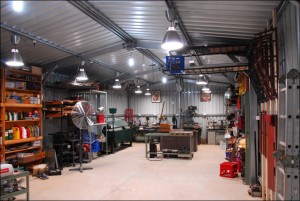Home Workshop Performance
Our ‘Building a Home Workshop’ series (starts here) has been very popular. So what’s the workshop like after being in use for 9 months? What’s been learned about its performance in that time?
Firstly, the excellent.
The lighting system (an expensive and very powerful system using a lot of suspended metal halide luminaries) is well worth the time and money involved in its installation. You can be working in the late afternoon and as evening falls, not even notice the change in lighting. You can work as efficiently in the middle of the night as the middle of the day.
The internal layout – the position of power points, machine tools and workbenches – has also proved excellent. The ‘island’ workbench is particularly effective, as is the proximity of the welding bench to the main workbench.
The tall headroom is also noticeable every time I swing a piece of tube or even carry the ladder. Talking about the ladder, the storage of items high up (clearing floor space) has also proved to work very well.
Now, the bad.
I chose to install two skylight panels on the north-facing part of the roof, down the end of the workshop furthest from the roller doors. These work well in that the summer heat build-up caused by their presence is limited but they still provide a lot of light. However, I should have used one more panel so that the back wall of the workshop (where the machine tools are located) was evenly illuminated. As it is now, on a cloudy day, the drill press, grinder and hydraulic press are a bit dim.
Ventilation is also not sufficient. Even with the two roller doors up, the twin whirligig ventilators working and a fan moving air within the workshop, the build-up of fumes while brazing or welding is excessive. This is one aspect I think I will have to change – either adding an extraction hood and exhaust fan over the welding bench or placing an opening window in the far wall.
Finally, the concrete floor has proved to be very soft, not just in the second batch (which I always knew was soft) but also in the first batch. To avoid damaging the floor, items cannot be dragged across it and nothing can be hammered on it.
Overall? Very happy indeed.

 Julian Edgar, 50, has been writing about car modification and automotive technology for nearly 25 years. He has owned cars with two, three, four, five, six and eight cylinders; single turbo, twin turbo, supercharged, diesel and hybrid electric drivelines. He lists his transport interests as turbocharging, aerodynamics, suspension design and human-powered vehicles.
Julian Edgar, 50, has been writing about car modification and automotive technology for nearly 25 years. He has owned cars with two, three, four, five, six and eight cylinders; single turbo, twin turbo, supercharged, diesel and hybrid electric drivelines. He lists his transport interests as turbocharging, aerodynamics, suspension design and human-powered vehicles.


on May 14th, 2009 at 5:22 pm
Julian, the soft concrete sounds like somewhat of an issue. Would it be possible to fix this by sealing/impregnating it with some sort of resin? I actually have a large piece of old house carpet covering most of the floor in the work area of my shed, and whilst it looks dirty and disgusting, this is quite good for avoiding damage to things placed on the floor, as well as inulation against cold weather. Could this be a solution for some areas of your workshop?
on May 15th, 2009 at 1:23 pm
Epoxy based leveling compounds are about 80mpa, you could pour one of those over the top.
on May 27th, 2009 at 9:42 am
Re. Concrete floor – I think it’s sometimes worth using higher strength concrete, say 30-40MPa, and not as thick. Builders may cringe at the extra cost, but this is offset by less transportation costs and less effort in digging foundations (particularly if it’s hand dug or under a house). And you also get a rock hard, smooth floor.
on May 28th, 2009 at 10:04 pm
I thought you where leaving?
Glad your back, its a relief
MORE hard hitting road tests please
on May 29th, 2009 at 11:53 am
Julian, thats the most disgusting , pornographic workshop picture I have EVER seen – its big, well set up, lotsa machine tools, tidy to an unnatural degree, good lighting, well thought out power distribution – why, you probably do real work in there.! AND you can probably find the spanner you want with relative ease – what a terrible role model for your son! Its like the glossy magazines, showing you things you will never possess. Your wife must be a saint to let you get away with this! Please – for those of us who think a concrete floor on the carport is sheer luxury (and we wont go into what happens when it rains) well, you are being deliberatively provocative
on June 2nd, 2009 at 6:01 pm
I drool over your shed ,mine is a 6×6 so placement of tools etc is critical so to have one that size would be luxury ! I put everything on wheels for ease of movement.
I used a recovered 5 blade ceiling fan in mine to disperse welding fumes. Workshop porn? bring it on !!
on June 25th, 2009 at 9:29 am
The trick with concrete floors when laying from new is to request a ‘hard trowelled’ finish. This is achieved by the concrete layer spending more time when finishing the surface, usually by machine. It produces a very smooth, hard surface. I used 25mpa on my shed and so far it’s holding up well. (Still stains with oil though)
on October 16th, 2009 at 11:01 pm
I think thats cheap
on December 10th, 2009 at 9:57 am
I also think that that is cheap